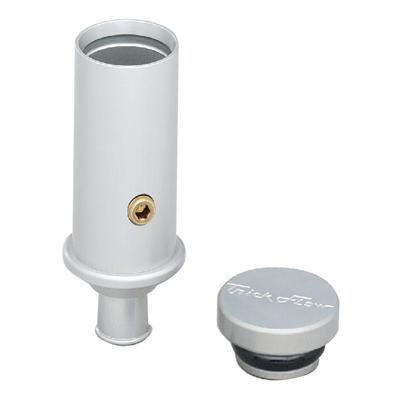Since everyone seems to like this idea, let me go into more detail. I will break it down into vacuum side and fresh air side. Also why you need both.
First off read and study this article. The diagrams will open to larger pics if you need to.
Ignore the section about the AOS (Air Oil Separator) it over complicates the project. What we are using is catch cans the separate out the oil differently.
What I will be discussing is the closed system, the diagram in the middle.
The vacuum side is the blue lines, Fresh air is the tan lines. No bikini here. Those running a carb can imagine the carb in place of the throttle body.
ok here we go. Whew I need more coffee.
You want the PCV connection In the
farthest forward port of the valve cover. The reason why, is that acceleration forces the oil to the back of the cover and you will suck a lot of that oil into the separator causing increased oil consumption and frequent emptying of the catch can. The valve doesn't need to be in the valve cover but at least somewhere in the system from the valve cover and the vacuum port. The other line will run from the catch can to some point after the throttle body or carb. Now that you have captured the oil and oil vapor you will not have a dirty intake or intake ports in the head. Yes on some intakes this will help solve the dead #8.
Oil and oil vapor in the intake reduces the octane rating which does result in pre ignition and reduced power. You may not be able to hear the pre ignition but it is happening. Now that you have eliminated the oil and vapor you may find you can now run more timing. Like 2 to 4 degrees more. You might even gain a mile or two in gas milage.
Yes you do need a PCV valve. It regulates the vacuum. At idle and cruise it limits the amount of vacuum in the PCV system. It will keep you from sucking too much out of the system. Eliminating increased oil consumption and frequent emptying catch can. During acceleration you have low vacuum so it opens wider to allow more flow. It is hard to tell in this pic but the blue part of the PCV valve is tapered.
Ok let's get to the fresh air side of the system. You want a catch can on this side as well.. It IS NOT for filtering the air coming into the engine. Your engine air filter does that. When you shut down a hot engine you have hot oil vapor escaping the crankcase. If the PCV valve is working correctly it can't escape on that side, so it escapes on the fresh air side. As it cools the vapor condenses into a liquid. This liquid puddles in the section between the air cleaner and throttle body.
You carb guys aren't left out either. How many of you have removed the air cleaner lid and found oil puddled inside? This is where that comes from? Guess what happens when you start that engine. It gets sucked in the TB or carb and into the engine. NOT what we want. Remember we are trying to eliminate any oil or vapor reaching the engine.
You guys running a TB with coolant lines for preheating the air in cold conditions have another problem. That heating actually cooks the oil and turns it into carbon. How many of you removed the TB and seen it black inside or had a sticking throttle because of carbon buildup? Most say bypass the TB coolant lines. Yeah sure no more carbon deposits but that doesn't fix the problem. The problem is stopping that oil and vapor from coming from the engine after shut down. This is why you need the 2nd can.
For the question about reversing the connections on the fresh air side. In the system diagram above look at the top side of both cans. On the vacuum side air is flowing from the engine to the top of the can. On the fresh air side with the engine running, air flows from the engine air filter to the side of the can and out the top to the engine. On shut down the hot engine vapors enter the top, condense and fall into the can trapping the oil in the catch can keeping them from entering the air intake system. You want to connect both valve covers to the top of each catch can.
I like running valve cover breathers with a PCV valve built into them. I remove the valve on the fresh air one. It does mean that I have remove one of the breathers to add oil. I am trying to eliminate that by adding an oil filler neck on the fresh air side.
427 Cobra & Replica Sales and Service. Complete hand built cars and loads of informative pages on Insurance, Specifications, Options, Photos and more! For the 427 SC, AC, Shelby Cobra, Superformance Mk-III, Factory Five, Shell Valley, ERA, and more...
performanceunlimited.com
I am considering adding this filler neck to the fresh air side. It is easy to plumb and the fresh air connects to the side of the filler neck. It does mean it is close to the firewall and may make it harder to add oil. You could put it on the vacuum side if you can figure out how to add a PCV valve somewhere on the vacuum system.

www.trickflow.com
With the Radium or Racetronix catch cans they have -10AN O ring ports, you can use a Radium PCV valve mounted to
side of the catch can, not the top. Pay attention to the arrow and the direction the air flows. You can get them barb for 3/8 hose or -6 AN.
Billet 10AN ORB PCV Valves
www.radiumauto.com
I hope I haven't completely confused everyone. Pros of running this time of PCV system is it reduces oil consumption, prevents a dirty intake and intake track, improves engine performance by preventing oil and vapor from entering the engine. Cons are it involves more plumbing, take up more space, and requires occasional emptying of the catch cans.
I know I have talked mostly about Radium and Racetronix. What I am saying is not marketing hype but actual facts. There is no reason not to use the Moroso catch cans. I hate their term AOS. The term AOS comes from the early days when boosted guys ran pneumatic air oil separators before people like Moroso Radium and Racetronix started making them.
Any of these Moroso catch cans or their universal ones would be fine.
Ford

www.moroso.com













